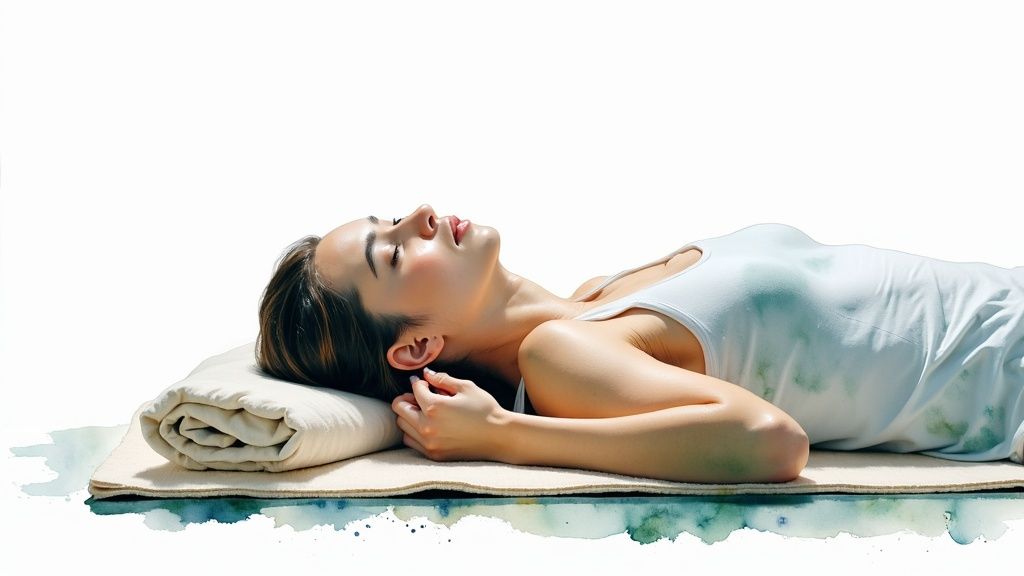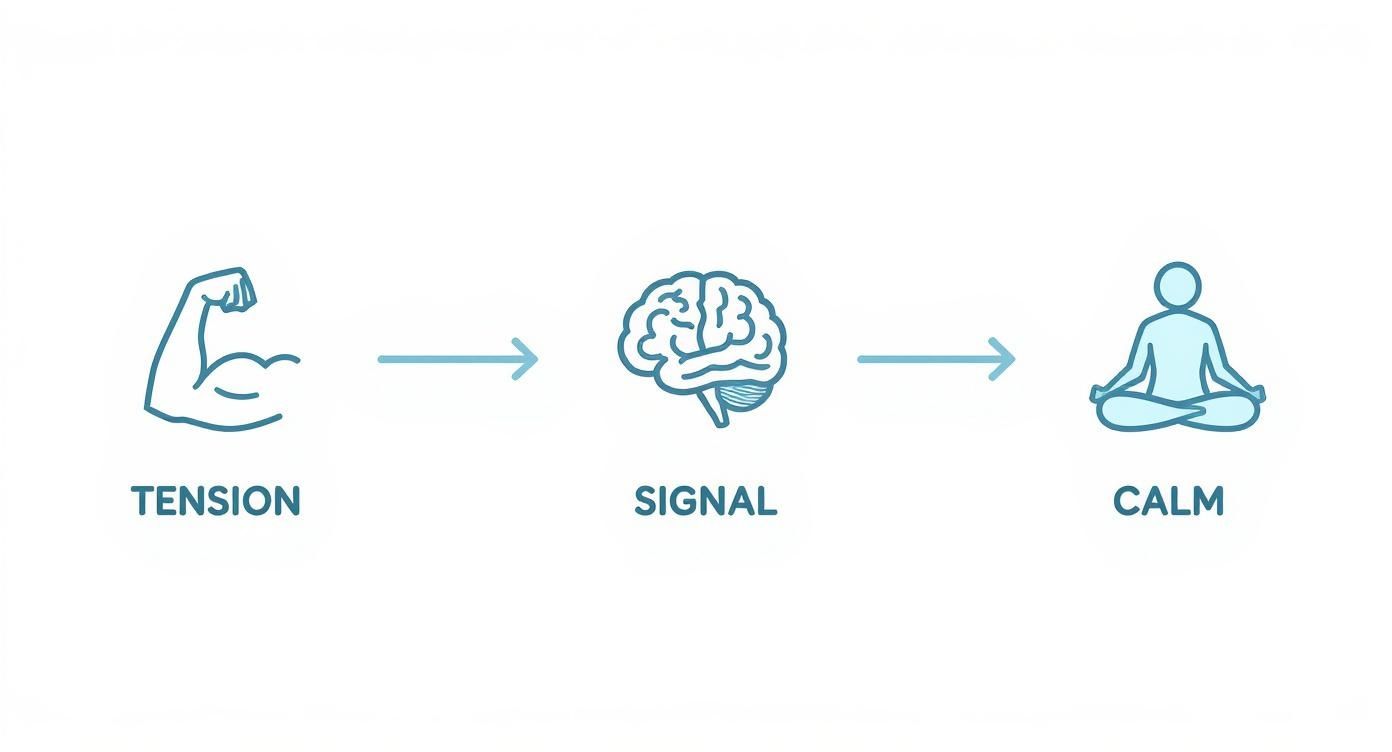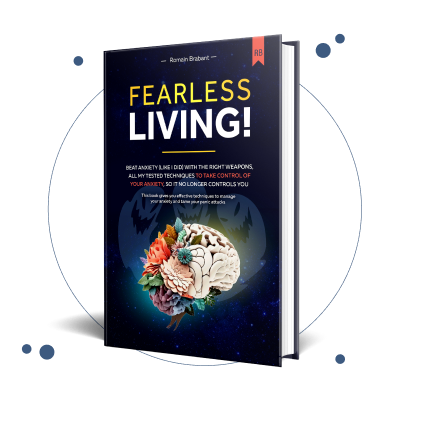
Progressive muscle relaxation is a powerful, body-based technique where you intentionally tense specific muscle groups for a few seconds and then, just as intentionally, let them go. This simple act is a profound way to teach your body the difference between tension and true relaxation.
It’s a direct method to interrupt your body's stress response, calm your nervous system, and find not just immediate relief, but a genuine path toward long-term healing from anxiety.
Find Hope and Take Back Control from Anxiety
When you're caught in the grip of anxiety or a panic attack, your body feels like it's been hijacked. Your muscles clench, your heart races, and your thoughts can spiral completely out of control. It’s an overwhelming experience that can leave you feeling powerless, wondering if you'll ever escape the cycle.
But there is a concrete, physical action you can take to reclaim control, and it starts with your own body. This is a message of hope: you have the power to heal.
Progressive muscle relaxation (PMR) is more than just a simple exercise; it’s a direct line of communication with your nervous system. By systematically tensing and then releasing different muscle groups, you send a powerful signal to your brain to shift out of "fight or flight" mode and into a state of rest and calm. This isn't just a hopeful idea—it's a physiological reality that can guide you back to peace.

Why This Simple Action Creates Profound Change
The real hope within PMR lies in its simplicity and the immediate feedback it provides. You don't need any special equipment or even a quiet room. You can do it discreetly at your desk before a big meeting or in your car when traffic gets stressful. This technique gives you a tangible tool to manage distress anytime, anywhere, putting the power to feel calm back into your hands.
The process offers a few key benefits on your path to a panic-free life:
- Interrupts the Panic Cycle: Anxiety creates physical tension, which then signals more anxiety to your brain. PMR breaks this destructive feedback loop, offering an immediate off-ramp from the cycle of fear.
- Builds Mind-Body Awareness: With practice, you'll learn to recognize the subtle signs of tension before they escalate into full-blown panic, empowering you to respond with calm instead of fear.
- Restores a Sense of Agency: Actively doing something to calm your body restores the sense of control that anxiety so often steals away. This is a critical step in healing.
This heightened awareness is a sign that you are healing. When you can feel the tension building in your shoulders before a panic attack begins, you have the power to release it and choose a different path.
The Science Behind the Calm
This isn't just about feeling better; it's about creating measurable physiological change. Clinical research consistently shows that PMR effectively reduces stress by calming the sympathetic nervous system—your body's internal alarm system.
Studies have reported that regular practice can lead to a 30-40% reduction in self-reported stress levels, essentially teaching your body a new, peaceful default response to triggers.
By learning progressive muscle relaxation, you are not just coping; you are actively rewiring your response to anxiety. This practice is a foundational skill, much like the other practical grounding techniques for anxiety that help anchor you in the present moment. It's about building a toolkit that reminds you that you are in control and that a calm, panic-free life is absolutely within your reach.
The Science of How PMR Calms Your Nervous System
To truly embrace a tool like this, it helps to understand why it works. Progressive muscle relaxation isn't just a mental trick or a distraction. It's a powerful, science-backed method that speaks directly to your body's stress wiring, giving you a tangible way to dial down anxiety and reclaim your peace.
The technique was developed in the 1920s by physician Edmund Jacobson, who discovered that by systematically tensing and then relaxing muscles, people could dramatically lower not just physical tension, but psychological stress, too. It was a groundbreaking discovery that offered real hope for healing.
How Tensing Actually Leads to Releasing
When you feel anxious, your body kicks into high gear. This is the sympathetic nervous system, better known as the fight-or-flight response, doing its job. It floods your system with stress hormones like cortisol and adrenaline, making your heart pound, your breathing go shallow, and your muscles clench up, ready for danger.
PMR is like a manual override for this whole automatic process.
When you deliberately tighten a muscle group for a few seconds, you're creating a moment of intense physical stress. Then, when you let it go, your brain gets a powerful, undeniable signal that the "danger" has passed.
This simple act of releasing flips the switch, activating the parasympathetic nervous system—your body’s built-in braking system.
Think of it like this: you are consciously telling your body it's safe to power down the alarm system and shift into "rest and digest" mode. You are showing yourself that you can create safety within.
And that's where the healing begins. The release triggers a cascade of calming physical changes. Your heart rate slows, your blood pressure drops, and your breathing naturally deepens. You aren't just hoping to feel calm; you're actively creating the biological conditions for calm to happen.
With consistent practice, you're doing more than just finding temporary relief. You are retraining your nervous system, teaching it a new, calmer default response. You start to notice tension as it builds, long before it snowballs into overwhelming anxiety or a full-blown panic attack. That is the feeling of taking your power back.
A Guided Progressive Muscle Relaxation Session
Knowing the science is one thing, but actually feeling the shift from tension to release? That’s where real hope takes root. This is your chance to experience that change firsthand.
I’m going to walk you through a full progressive muscle relaxation exercise. Think of this as a safe space to connect with your body and actively let go of the anxiety it’s been holding onto, reminding yourself that peace is possible.
Let’s get started. Find a quiet place where you won’t be disturbed for the next 15-20 minutes. You can lie down on your back or get comfortable in a chair with your feet flat on the floor. Gently close your eyes and just take a few slow, deep breaths. Pay attention to the air filling your lungs and then how it feels as it slowly leaves your body.
Setting the Stage for Relaxation
The rhythm of your breath is the foundation of this practice. It’s simple: as we move through each muscle group, you’ll inhale as you tense and exhale as you release.
This pairing is so important because it anchors the physical release to the calming, physiological act of a slow exhale. If you want to dive deeper into how your breath can regulate your nervous system, exploring other breathing exercises for anxiety is a powerful way to complement what we’re doing here.
A quick but important tip: the goal is not to tense with all your might. You want to apply just enough pressure to feel the muscles engage—about 70% of your maximum effort is the sweet spot. We're creating noticeable tension, not strain or pain.
Hold that tension for about 5 seconds, then let the release last for 10-15 seconds. Really savor that feeling of letting go.
This simple process sends a direct signal to your nervous system to stand down, interrupting the feedback loop that fuels so much anxiety and showing you a path out.

As you can see, the physical act of tensing and releasing sends a direct message to your brain, activating your body's natural relaxation response and paving the way for calm.
Moving Through Your Body
We're going to start at your feet and work our way up. This sequence helps you systematically scan your entire body for hidden tension you might not even realize you're carrying.
Here's a breakdown of the timing we'll use for each muscle group.
Guided Session Timing for Muscle Groups
| Muscle Group | Tense (seconds) | Relax (seconds) |
|---|---|---|
| Feet and Calves | 5 | 10-15 |
| Thighs | 5 | 10-15 |
| Hands and Arms | 5 | 10-15 |
| Stomach and Chest | 5 | 10-15 |
| Shoulders and Neck | 5 | 10-15 |
| Face | 5 | 10-15 |
This rhythm of tension and extended release is what makes the practice so effective. Let’s begin.
- Feet and Calves: Start by curling your toes tightly and pointing your feet downward. Inhale and hold for 5 seconds… Now, exhale and release all of it. Just notice the warmth and heaviness as those muscles completely let go.
- Thighs: Next, squeeze your thigh muscles by pressing your knees toward each other. Inhale, hold that tension… Then, exhale and let your legs go completely limp.
- Hands and Arms: Clench both of your fists and flex your biceps, bringing your forearms up toward your shoulders. Inhale and squeeze… Now, exhale and let your arms fall heavy by your sides. Really feel the difference between that tension and this state of relaxation.
- Stomach and Chest: Tighten your abdominal muscles, almost like you’re bracing for an impact. Inhale and hold… Exhale completely, letting your stomach soften and your chest open up and relax.
- Shoulders and Neck: Raise your shoulders all the way up toward your ears. Inhale and feel that tension build across your upper back… As you exhale, let your shoulders drop completely. Feel that weight just lift away.
- Face: Finally, clench your jaw, squint your eyes, and furrow your brow. Inhale and hold all that tension in your face… Exhale and let every single muscle go slack. Allow your jaw to hang slightly open.
Take a final moment to scan your entire body. Notice how different you feel now compared to when we started. This state of deep physical relaxation is always available to you. You just created it yourself. This is what healing feels like.
Integrating PMR into Your Daily Life for Lasting Calm

True, lasting freedom from anxiety isn’t found in a single, perfect session. It’s built through small, consistent actions that eventually become a natural part of your life. Think of progressive muscle relaxation not just as a crisis tool, but as a daily practice that strengthens your ability to stay calm, centered, and in control.
This consistency is the real foundation for a panic-free life. It's a journey of hope, one breath at a time.
Weaving PMR into your daily rhythm doesn't have to feel like another chore. It’s about finding small pockets of time to intentionally connect with your body and release the tension that anxiety quietly builds up. By doing this, you're not just coping—you're proactively rewiring your response to stress and building a life with more peace.
Building a PMR Habit That Sticks
The easiest way to make a new habit stick? Attach it to something you already do every day. Think about the moments in your day when you could most use a quick reset. When the practice becomes second nature, it’s always there for you when you need it most.
Here are a few practical ideas to get you started:
- Morning Calm: Before you even get out of bed, try a 10-minute PMR session. This sets a grounded, hopeful tone for the entire day, helping you face challenges from a place of calm rather than reactivity.
- Commute De-Stress: Stuck in traffic? Instead of letting frustration build, use it as your cue. You can discreetly tense and release your hands on the steering wheel, or your shoulders and neck, to dissolve that built-up stress right there in the car.
- Pre-Meeting Reset: Got a stressful presentation or a difficult conversation coming up? Find a quiet corner for a 3-minute modified session. Just focusing on your hands, jaw, and shoulders can make a world of difference in your confidence.
- Nightly Wind-Down: A full 15-minute practice before sleep is a powerful way to let go of the day’s tension. This can dramatically improve your sleep quality, which is absolutely crucial for healing from anxiety.
By integrating these small practices, you are constantly reminding your nervous system that it is safe. This repeated signal is what gradually rewires your stress response, making calm your new default state and proving that a panic-free life is possible.
The global reach of PMR really speaks to its effectiveness and accessibility. From its origins back in the 1920s, it has become a staple in hospitals and wellness programs worldwide. For instance, the U.S. Department of Veterans Affairs actively promotes PMR to help manage PTSD and chronic pain, often seeing measurable improvements after just a few weeks of consistent practice.
Pairing PMR with other tools like journaling or mindfulness creates an even more robust toolkit for your mental health. It’s all about discovering natural ways to boost mood and improve overall well-being. For a deeper dive, our guide on meditation for anxiety explores how you can build a comprehensive practice that truly fits your life.
This journey is about empowering yourself with skills that bring you closer to the calm, fearless life you deserve.
Common Mistakes and How to Practice Safely
To truly feel the healing power of progressive muscle relaxation, your practice needs to feel safe and supportive. It’s easy to make a few common mistakes that can leave you feeling frustrated instead of relaxed. This isn’t about perfection; it’s about creating a compassionate space for your body to finally let go.
One of the biggest pitfalls is tensing your muscles too forcefully. The goal here is noticeable tension, not strain or pain. Think of it like making a firm fist, not a white-knuckled grip. Tensing too hard can lead to cramping and might even spike your anxiety—the exact opposite of what we want.
Another common slip-up is holding your breath while you tense. Your breath is your anchor to calm, so don’t abandon it. The rhythm is simple: inhale as you tense, then exhale slowly and completely as you release. This pairing sends a powerful signal to your nervous system that it’s safe to stand down. Rushing through the sequence is another way to shortchange yourself. Savor that feeling of release for at least 10-15 seconds to truly let the relaxation sink in.
Safe Practice for Every Body
For PMR to be a healing tool, it has to honor your body’s unique needs. If you live with chronic pain, an old injury, or a condition like arthritis, safety is everything. The good news is that PMR is incredibly adaptable.
You don’t have to push through pain to find peace. The gentle act of releasing tension is powerful enough on its own to calm your nervous system and build a foundation for a panic-free life. Hope is found in gentleness, not force.
If tensing a certain muscle group triggers pain, don’t do it. You can either skip that area entirely or try a simple modification.
- Try the "Release-Only" Version: Instead of tensing, just bring your awareness to a muscle group. As you exhale, consciously imagine all the tightness and tension melting away from that area.
- Listen to Your Body: If a muscle is just a bit sore, be extra gentle with it. The whole point is to create relief, not more discomfort.
These simple adjustments ensure your practice always feels restorative. This mindful approach helps you build a routine that supports your long-term healing, reminding you that you have the power to create calm and safety within yourself, no matter what’s going on.
Your Path to a Panic-Free Life
Living with anxiety can feel isolating, but finding lasting peace is truly possible. It's not about an overnight transformation, but about the small, consistent steps you take that slowly turn the tide from panic to a calm, sustainable rhythm. This is how healing happens.
The real magic unfolds when you start weaving PMR into the fabric of your daily life. With each session, you're not just relaxing your muscles; you're reclaiming a sense of control and proving to yourself, one intentional release at a time, that you can live panic-free.
Think about someone like Maria. She felt completely trapped by her panic attacks until she started a simple PMR practice each morning. Within a few weeks, she noticed the constant hum of anxiety was quieter, and she was having more moments of genuine clarity and hope.
- Morning Ritual: A quick 10-minute session before breakfast can set a calm, centered tone for your entire day.
- On-the-Go Reset: Stuck in traffic? Tensing and releasing your hands on the steering wheel can dissolve that rush-hour tension.
- Wind-Down Habit: A 15-minute PMR practice before bed does wonders for sleep quality.
- Midday Micro-Break: Feeling overwhelmed at work? Three deep, focused tenses during a coffee break can short-circuit a rising panic cycle.
Picture this: you're in a stressful moment—maybe waiting for important news. Your heart starts to race. Under the table, where no one can see, you slowly squeeze your forearms, hold for a few seconds, and then release. This tiny, discreet action creates a micro-break, grounding you and calming your nervous system. It's a simple skill that has helped so many people stay centered when worry starts to peak.
- Identify where you're holding tension (shoulders and jaw are common culprits).
- Apply a discreet 3-second squeeze to that area.
- Release slowly as you exhale, focusing on the feeling of relief.
How to Track Your Progress
Jotting down your PMR sessions helps you see the patterns and, more importantly, celebrate the small wins. It's tangible proof that you are moving forward on your healing journey.
You can use a simple journal or even our interactive Anxiety Checklist spreadsheet to note when you practiced and what you noticed.
"Small changes compound into big resilience," says Romain, the creator of The Anxiety Checklist.
Sustaining Your Hope
Hope isn't something you just have; it's something you build. It grows every time you notice a little progress, no matter how small it seems.
Set realistic goals for yourself—maybe aiming for three PMR sessions a week. This keeps you moving forward without feeling overwhelmed.
And for those days when motivation is low (we all have them), revisiting the success stories in our Anxiety Recovery Steps guide can be a powerful reminder that you're on the right path and that healing is happening.
Each time you practice, you're reinforcing a new baseline, making the next session feel just a little bit easier. Over a few months, these small shifts compound into a profound sense of control and calm.
Every single day you practice, you're sending a powerful message to your body: safety isn't somewhere "out there"—it's right here, within you.
This growing confidence starts to bleed into every corner of your life, from your relationships to your work.
Remember, the key to a calmer life is quite literally at your fingertips.
Keep going—you've got this. A panic-free life is waiting for you.
Your PMR Questions, Answered
Starting something new like progressive muscle relaxation always brings up a few questions. That's a good thing. Getting clear answers helps build the confidence you need to stick with it and see real, lasting change on your path to healing.
Let's dive into some of the most common questions people have when they first start out.
How Soon Can I Expect to Feel a Difference?
Some people feel a wave of calm after their very first session, which is a wonderful sign of hope. But the real, life-changing magic of PMR comes from consistent practice. You might notice a subtle drop in your baseline anxiety within the first week or two.
The bigger goal here is to retrain your nervous system, and that happens gradually. After about a month of regular practice, many people report feeling less reactive to stress, sleeping better, and having a much stronger sense of control when anxiety tries to creep in.
This isn't a quick fix; it's a sustainable way to build a calmer, panic-free life.
Do I Need Any Special Equipment?
Absolutely not. That’s one of the best things about PMR. All you need is yourself and a few quiet minutes.
No special mat, no fancy cushion, no app required. This practice is ready to go whenever and wherever you are—in bed, at your office desk, or even sitting in your car waiting for an appointment. Having a tool this accessible gives you a powerful sense of control over your own well-being and your healing journey.
How Often Should I Practice for the Best Results?
Consistency beats duration every time. When you're starting out, aim for a 10-15 minute session at least 3-5 times per week. That's enough to start building a strong foundation of calm.
Many people find that a short daily practice—even just five minutes in the morning or before bed—creates the most significant long-term shift in their anxiety levels.
Think of it this way: the more you practice, the stronger you make the neural pathways that lead to relaxation. You're actively teaching your body that calm is its natural state, building resilience against anxiety one session at a time. This is how you heal.
What if I Have Physical Limitations or Pain?
PMR is incredibly adaptable. If you have an injury, chronic pain, or a condition like arthritis that makes tensing certain muscles difficult or painful, you should never force it. Your practice should always feel safe and restorative.
Instead, you can use a "release-only" modification. Just bring your awareness to a muscle group, and as you exhale, simply imagine all the tension melting away from that area without ever tensing it first. This gentle approach still activates the relaxation response and is a beautiful way to show compassion to your body as it heals.
The Anxiety Checklist provides a structured way to integrate powerful tools like PMR into a complete system for managing anxiety. To learn more about how to build your own personalized toolkit for a fearless life, visit the official Anxiety Checklist website.

